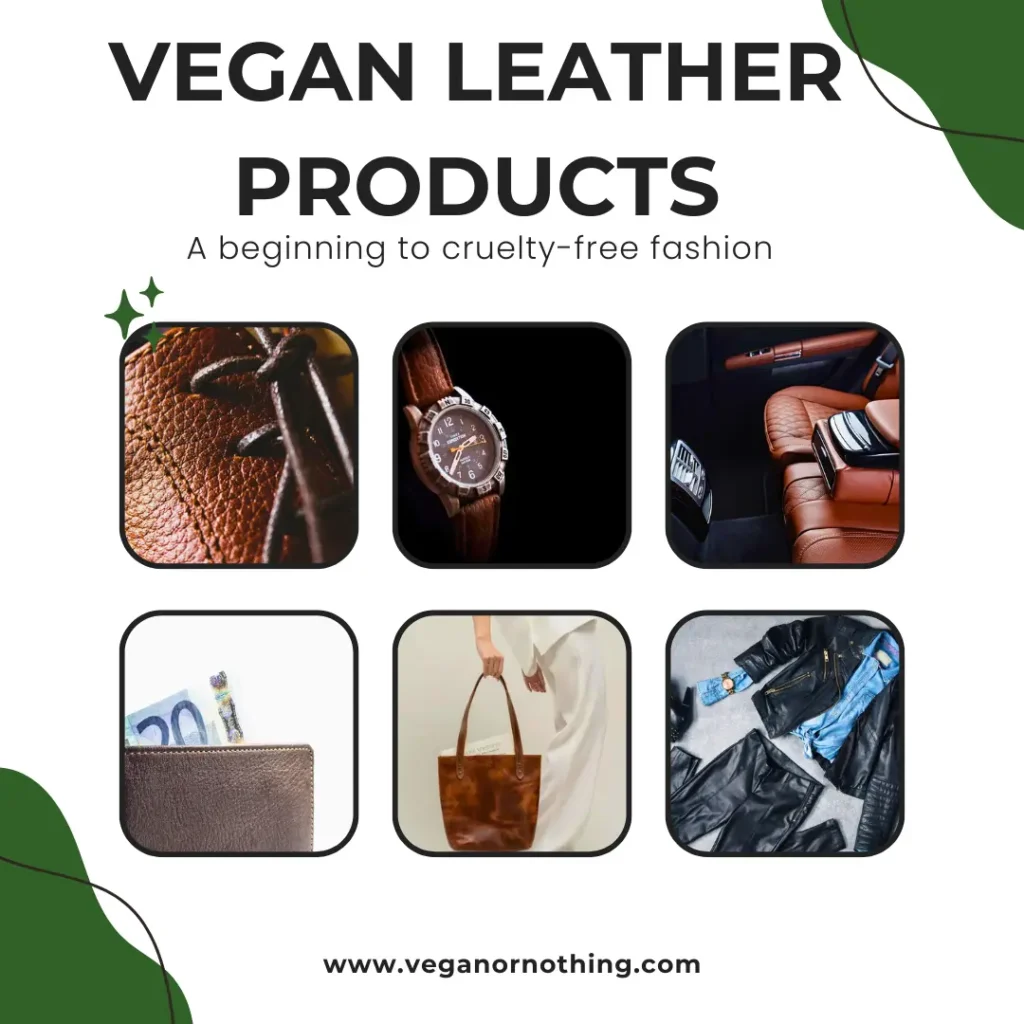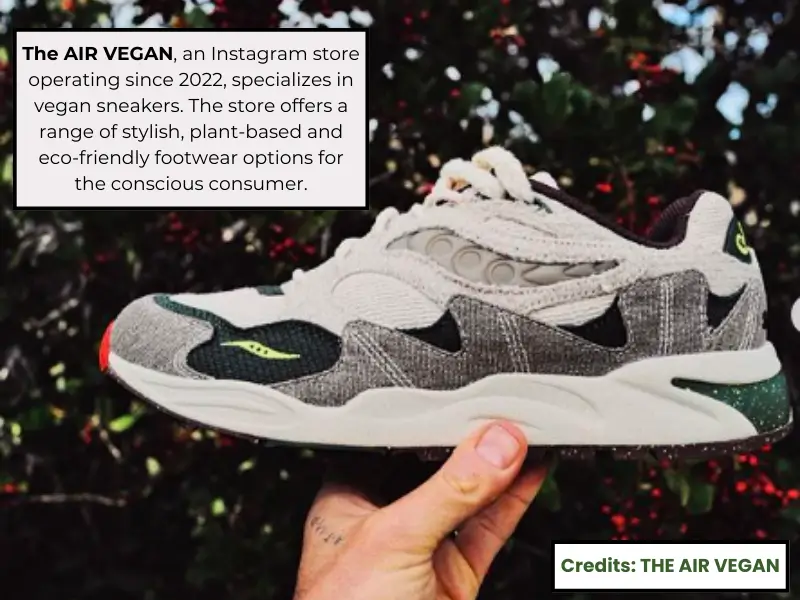Read time: 9 mins.
Table of Contents
Introduction
Imagine discovering a leather alternative that doesn’t come from the skin of dead animals—sounds too good to be true, right? Well, that’s precisely what we found in vegan leather.
It all started when we took a hard look at our wardrobe and realized just how many of our clothing items and shoes were made by harming animals. Determined to make a change, we sold off everything from leather jackets to Mark’s beloved wallet.

With a newfound commitment to cruelty-free living, we began searching for alternatives. That’s when we stumbled upon vegan leather. The discovery was a relief, offering us a way to stay stylish without compromising our values and giving us hope for a more ethical future.
Join me as we dive into the world of vegan leather—what it is, how it’s made, and why it’s a fantastic choice for conscious consumers.
What is Vegan Leather?
Vegan leather is a sustainable and cruelty-free alternative to traditional leather, as it’s not made from dead animals. One of its standout features is its eco-friendliness, which aligns with the growing demand for environmentally conscious products. By choosing vegan leather, you’re part of a larger movement towards a more sustainable future.

Typically made from polyurethane, vegan leather can be created using innovative ingredients like apple peels, recycled plastic, and more. For example, Desserto, a company known for its creativity, produces vegan leather from cactus—how fascinating is that?
The versatility of vegan leather is truly exciting. You can find almost any product made from it. The options are vast, from shoes, boots, and handbags to seat covers. Even car manufacturers like Tesla, which is my dream car, offer vegan leather seating options.

The popularity of vegan leather has also caught the attention of celebrities. Kylie Jenner, for instance, has embraced this trend with her brand, Khy, which uses vegan leather. This shift towards cruelty-free and sustainable materials is a win for animal welfare and the planet, proving that style and ethics can go hand in hand.
Also Read: Why Vegan Butter is the Best Choice for Your Heart and Planet
A Complete Range of Vegan Products
- Vegan Leather Jackets

- Vegan Wallets

- Vegan Leather Backpacks

- Vegan Leather Belts

- Vegan Leather Sneakers

- Vegan Leather Pants

- Vegan Leather Boots

Vegan Leather vs. Real Leather
Real Leather:
Real leather is crafted from animal skin through an intricate and lengthy process. The hide is salted and soaked in calcium oxide to remove hair and impurities. It is then tanned and treated with various chemicals or natural materials to achieve the desired texture and durability. This process, known as “liquoring,” gives the leather its signature earthy scent and breathable qualities.

There are two primary tanning methods for real leather:
- Chromium Tanning:
- Utilizes chemicals to produce a durable and water-resistant material.
- Offers superior resistance to heat and water, making it highly durable.
- However, it generates chromium waste, which can significantly pollute waterways.
- Vegetable Tanning:
- Uses natural materials like tree bark, avoiding harmful chemicals.
- Produces a more eco-friendly leather, though it is generally more expensive.
- The leather created is often stiffer but softens over time and use.
Real leather can last multiple decades with proper care, becoming more supple and characterful with age. Its durability and classic appeal make it a long-lasting material, but its production raises ethical and environmental concerns.
Vegan Leather:
Vegan leather, on the other hand, has emerged as a cruelty-free and eco-friendly alternative. Recent advancements have made it feel increasingly similar to real leather. Despite this, vegan leather typically lasts only 2-5 years, necessitating more frequent replacements than its traditional counterpart.

Vegan leather is a more environmentally conscious choice, reducing reliance on cattle and thus cutting deforestation and greenhouse gas emissions. However, it does face some challenges:
- Shorter Lifespan: Vegan leather’s shorter lifespan means it needs to be replaced more often, which can be less economical in the long run.
- Plastic-Based Options: Some vegan leathers, like PVC, do not biodegrade well and can release pollutants. While initially attractive, these materials pose environmental hazards.
- PU Leather: While PU leather is less harmful than PVC, it is still derived from fossil fuels. This makes it less eco-friendly than natural materials, even though it avoids the ethical issues associated with animal-derived leather.
While real leather offers durability and a timeless appeal, its ethical and environmental costs are significant. Vegan leather provides a compassionate and more sustainable option but comes with its own challenges. The choice between the two often comes down to personal values and priorities regarding sustainability, ethics, and longevity.
Is Vegan Leather Better Than Real Leather?
The debate over whether vegan leather is better than genuine leather hinges on various factors, including environmental impact, durability, and ethical considerations.
Vegan Leather:
Vegan leather can be problematic when made from plastic materials like PVC and PU, which can release harmful pollutants and do not biodegrade well. However, eco-friendly alternatives exist, such as those made from natural materials like apple peels, cactus, and recycled plastics. These options significantly reduce the environmental footprint compared to traditional leather. Despite its benefits, vegan leather generally has a shorter lifespan, requiring more frequent replacements and potentially contributing to waste.
Real Leather:
Real leather production is associated with high carbon emissions and significant ethical concerns due to its reliance on animal hides. Sustainable options do exist within the real leather industry, including:
- Proper care to extend the product’s lifespan, making it a long-lasting choice.
- Purchasing leather as a meat byproduct, mainly when tanned with vegetable methods, which avoids harmful chemicals.
- Supporting producers who work with small farms, ensuring more ethical and sustainable practices.

Overall Sustainability:
Both vegan and real leather have room for improvement in terms of sustainability. Making informed decisions about leather purchases, whether vegan or not, is crucial. Opting for products made with eco-friendly practices, supporting ethical producers, and considering the longevity of the items can help reduce the overall environmental impact.
Is Vegan Leather Durable?
The durability of vegan leather depends on several factors, including the quality of materials used, thickness, construction, maintenance, and environmental conditions.
Vegan Leather Durability Factors:
- Quality of Materials Used: High-quality vegan leather made from advanced materials like PU, plant-based materials, or recycled plastics tends to be more durable.
- Thickness: Thicker vegan leather can withstand more wear and tear, similar to thicker animal leather.
- Construction: Well-constructed products with reinforced stitching and quality craftsmanship enhance the durability of vegan leather items.
- Maintenance: Regular care and proper maintenance can extend the life of vegan leather, preventing cracks and preserving its appearance.
- Environmental Conditions: Exposure to extreme temperatures, humidity, or direct sunlight can affect the lifespan of vegan leather, just as it does with real leather.
Impact of Fast Fashion:
The fast-fashion industry often compromises on quality, producing low-quality materials labeled vegan leather. These products are typically not durable and do not offer the environmental benefits of genuine, high-quality vegan leather. Such items can deteriorate quickly, contributing to waste and undermining the sustainable promise of vegan leather.

Ensuring Durability:
Just like real leather, vegan leather comes in various qualities. To ensure durability, it is essential to research the company, its production methods, and the materials it uses. High-quality vegan leather products from reputable companies are designed to last longer and withstand daily use.
By choosing well-made items and taking good care of them, consumers can enjoy the benefits of vegan leather while maintaining durability and supporting more sustainable fashion practices.
Disadvantages of Vegan Leather
Quality of Vegan Leather:
Vegan leather generally does not match the high quality of real leather. While it is often textured to mimic genuine leather, it is frequently recognizable by its plastic-like appearance and shine. This can detract from the authentic look and feel many seek in leather products. Additionally, vegan leather is more susceptible to damage and tends to wear out more quickly than real leather, necessitating more frequent replacements.
Properties and Issues of Vegan Leather:
Vegan leather can have an unpleasant plastic or toxic chemical smell, although this typically fades over time. Unlike real leather, vegan leather is non-breathable, making it more prone to cracking and other damage. This lack of breathability can also result in discomfort during prolonged use. There are also significant sustainability concerns associated with vegan leather, especially when it is made from non-biodegradable plastic-based materials such as PVC and PU. These materials do not decompose well and can release harmful pollutants, raising essential questions about their long-term environmental impact. The lower durability of vegan leather often encourages repeat purchases, which can negate some of the environmental benefits of choosing vegan options in the first place.

Durability of Real Leather:
Real leather is known for its superior durability. It stands the test of time and daily wear and tear better than vegan leather. With proper maintenance, real leather can last for decades, significantly reducing the need for replacements. This longevity makes real leather more cost-effective over time and minimizes waste and environmental impact, provided the leather is sourced and processed sustainably.
Conclusion
In the debate between vegan leather and real leather, the choice ultimately hinges on personal values and priorities. As a committed vegan, I stand by the benefits of vegan leather despite its challenges. While it may not match the quality and durability of real leather, recent advancements have significantly improved its look and feel. Vegan leather offers a cruelty-free, eco-friendly alternative that reduces our reliance on animal products, helping to reduce deforestation and greenhouse gas emissions.
Yes, vegan leather can be less durable and sometimes made from non-biodegradable materials. However, innovations like cactus-based and apple-peel leather pave the way for more sustainable options. By supporting companies prioritizing quality and environmental responsibility, we can drive further improvements in vegan leather production.
Choosing vegan leather is a step toward a more compassionate and sustainable future. It’s about making informed decisions and supporting the continued evolution of eco-friendly materials. Join me in embracing vegan leather and contributing to a world where fashion doesn’t come at the cost of animal lives or our planet’s health.

